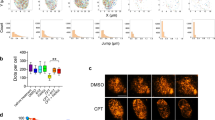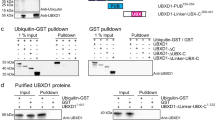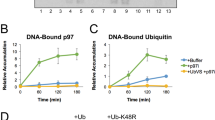Abstract
Protein ubiquitylation is a complex enzymatic process that results in the covalent attachment of ubiquitin, through Gly-76 of ubiquitin, to an ɛNH2 group of an internal lysine residue in a given substrate. Although E3 ligases frequently use lysines adjacent to the degron within the substrate, many substrates can be targeted to the proteasome through the polyubiquitylation of any lysine. We have assessed the role of lysine residues proximal to the cyclin D1 phosphodegron for ubiquitylation by the SCFFbx4/αB-crystallin ubiquitin ligase and subsequent proteasome-dependent degradation of cyclin D1. The work described herein reveals a requisite role for Lys-269 (K269) for the rapid polyubiquitin-mediated degradation of cyclin D1. Mutation of Lys-269, which is proximal to the phosphodegron sequence surrounding Thr-286 in cyclin D1, not only stabilizes cyclin D1 but also triggers cyclin D1 accumulation within the nucleus, thereby promoting cell transformation. In addition, D1-K269R is resistant to genotoxic stress-induced degradation, similar to non-phosphorylatable D1-T286A, supporting the critical role for the post-translational regulation of cyclin D1 in response to DNA-damaging agents. Strikingly, although mutation of lysine 269 to arginine inhibits cyclin D1 degradation, it does not inhibit cyclin D1 ubiquitylation in vivo, showing that ubiquitylation of a specific lysine can influence substrate targeting to the 26S proteasome.
This is a preview of subscription content, access via your institution
Access options
Subscribe to this journal
Receive 50 print issues and online access
$259.00 per year
only $5.18 per issue
Buy this article
- Purchase on Springer Link
- Instant access to full article PDF
Prices may be subject to local taxes which are calculated during checkout





Similar content being viewed by others
References
Aggarwal P, Lessie MD, Lin DI, Pontano L, Gladden AB, Nuskey B et al. (2007). Nuclear accumulation of cyclin D1 during S phase inhibits Cul4-dependent Cdt1 proteolysis and triggers p53-dependent DNA rereplication. Genes Dev 21: 2908–2922.
Barbash O, Zamfirova P, Lin DI, Chen X, Yang K, Nakagawa H et al. (2008). Mutations in Fbx4 inhibit dimerization of the SCF(Fbx4) ligase and contribute to cyclin d1 overexpression in human cancer. Cancer Cell 14: 68–78.
Benzeno S, Lu F, Guo M, Barbash O, Zhang F, Herman JG et al. (2006). Identification of mutations that disrupt phosphorylation-dependent nuclear export of cyclin D1. Oncogene 25: 6291–6303.
Bloom J, Amador V, Bartolini F, DeMartino G, Pagano M . (2003). Proteasome-mediated degradation of p21 via N-terminal ubiquitinylation. Cell 115: 71–82.
Breitschopf K, Bengal E, Ziv T, Admon A, Ciechanover A . (1998). A novel site for ubiquitination: the N-terminal residue, and not internal lysines of MyoD, is essential for conjugation and degradation of the protein. EMBO J 17: 5964–5973.
Diehl JA, Cheng M, Roussel MF, Sherr CJ . (1998). Glycogen synthase kinase-3beta regulates cyclin D1 proteolysis and subcellular localization. Genes Dev 12: 3499–3511.
Diehl JA, Zindy F, Sherr CJ . (1997). Inhibition of cyclin D1 phosphorylation on threonine-286 prevents its rapid degradation via the ubiquitin-proteasome pathway. Genes Dev 11: 957–972.
Feng Q, Sekula D, Guo Y, Liu X, Black CC, Galimberti F et al. (2008). UBE1L causes lung cancer growth suppression by targeting cyclin D1. Mol Cancer Ther 7: 3780–3788.
Feng Q, Sekula D, Muller R, Freemantle SJ, Dmitrovsky E . (2007). Uncovering residues that regulate cyclin D1 proteasomal degradation. Oncogene 26: 5098–5106.
Fung TK, Yam CH, Poon RY . (2005). The N-terminal regulatory domain of cyclin A contains redundant ubiquitination targeting sequences and acceptor sites. Cell Cycle 4: 1411–1420.
Germain D, Russell A, Thompson A, Hendley J . (2000). Ubiquitination of free cyclin D1 is independent of phosphorylation on threonine 286. J Biol Chem 275: 12074–12079.
Gladden AB, Woolery R, Aggarwal P, Wasik MA, Diehl JA . (2006). Expression of constitutively nuclear cyclin D1 in murine lymphocytes induces B-cell lymphoma. Oncogene 25: 998–1007.
Hershko A, Heller H, Eytan E, Kaklij G, Rose IA . (1984). Role of the alpha-amino group of protein in ubiquitin-mediated protein breakdown. Proc Natl Acad Sci USA 81: 7021–7025.
Kato J, Matsushime H, Hiebert SW, Ewen ME, Sherr CJ . (1993). Direct binding of cyclin D to the retinoblastoma gene product (pRb) and pRb phosphorylation by the cyclin D-dependent kinase CDK4. Genes Dev 7: 331–342.
Lin DI, Barbash O, Kumar KG, Weber JD, Harper JW, Klein-Szanto AJ et al. (2006). Phosphorylation-dependent ubiquitination of cyclin D1 by the SCF (FBX4-alphaB crystallin) complex. Mol Cell 24: 355–366.
Lin J, Beerm DG . (2004). Molecular biology of upper gastrointestinal malignancies. Semin Oncol 31: 476–486.
Matsushime H, Quelle DE, Shurtleff SA, Shibuya M, Sherr CJ, Kato JY . (1994). D-type cyclin-dependent kinase activity in mammalian cells. Mol Cell Biol 14: 2066–2076.
Moreno-Bueno G, Rodriguez-Perales S, Sanchez-Estevez C, Hardisson D, Sarrio D, Prat J et al. (2003). Cyclin D1 gene (CCND1) mutations in endometrial cancer. Oncogene 22: 6115–6118.
Parry D, Mahony D, Wills K, Lees E . (1999). Cyclin D-CDK subunit arrangement is dependent on the availability of competing INK4 and p21 class inhibitors. Mol Cell Biol 19: 1775–1783.
Pontano LL, Aggarwal P, Barbash O, Brown EJ, Bassing CH, Diehl JA . (2008). Genotoxic stress-induced cyclin D1 phosphorylation and proteolysis are required for genomic stability. Mol Cell Biol 28: 7245–7258.
Sato Y, Itoh F, Hareyama M, Satoh M, Hinoda Y, Seto M et al. (1999). Association of cyclin D1 expression with factors correlated with tumor progression in human hepatocellular carcinoma. J Gastroenterol 34: 486–493.
Scherer DC, Brockman JA, Chen Z, Maniatis T, Ballard DW . (1995). Signal-induced degradation of I kappa B alpha requires site-specific ubiquitination. Proc Natl Acad Sci USA 92: 11259–11263.
Shirane M, Harumiya Y, Ishida N, Hirai A, Miyamoto C, Hatakeyama S et al. (1999). Down-regulation of p27(Kip1) by two mechanisms, ubiquitin-mediated degradation and proteolytic processing. J Biol Chem 274: 13886–13893.
Worsley SD, Jennings BA, Khalil KH, Mole M, Girling AC . (1996). Cyclin D1 amplification and expression in human breast carcinoma: correlation with histological prognostic markers and oestrogen receptor expression. Clin Mol Pathol 49: M46–M50.
Wu G, Xu G, Schulman BA, Jeffrey PD, Harper JW, Pavletich NP . (2003). Structure of a beta-TrCP1-Skp1-beta-catenin complex: destruction motif binding and lysine specificity of the SCF(beta-TrCP1) ubiquitin ligase. Mol Cell 11: 1445–1456.
Zheng N, Schulman BA, Song L, Miller JJ, Jeffrey PD, Wang P et al. (2002). Structure of the Cul1-Rbx1-Skp1-F boxSkp2 SCF ubiquitin ligase complex. Nature 416: 703–709.
Acknowledgements
We wish to thank Serge Fuchs for the plasmids encoding the various ubiquitin lysine–arginine mutants, and Petia Zamfirova and Margarita Romero for their technical assistance. This work was supported by CA93237 (NIH) and a Leukemia & Lymphoma Scholar award (JAD).
Author information
Authors and Affiliations
Corresponding author
Rights and permissions
About this article
Cite this article
Barbash, O., Egan, E., Pontano, L. et al. Lysine 269 is essential for cyclin D1 ubiquitylation by the SCFFbx4/αB-crystallin ligase and subsequent proteasome-dependent degradation. Oncogene 28, 4317–4325 (2009). https://doi.org/10.1038/onc.2009.287
Received:
Revised:
Accepted:
Published:
Issue Date:
DOI: https://doi.org/10.1038/onc.2009.287
Keywords
This article is cited by
-
Tumor suppressor mediated ubiquitylation of hnRNPK is a barrier to oncogenic translation
Nature Communications (2022)
-
CRL4AMBRA1 is a master regulator of D-type cyclins
Nature (2021)
-
Suppression of the USP10/CCND1 axis induces glioblastoma cell apoptosis
Acta Pharmacologica Sinica (2021)
-
Phosphorylation-dependent regulation of SCFFbx4 dimerization and activity involves a novel component, 14-3-3ɛ
Oncogene (2011)
-
Critical roles of NOTCH1 in acute T-cell lymphoblastic leukemia
International Journal of Hematology (2011)



